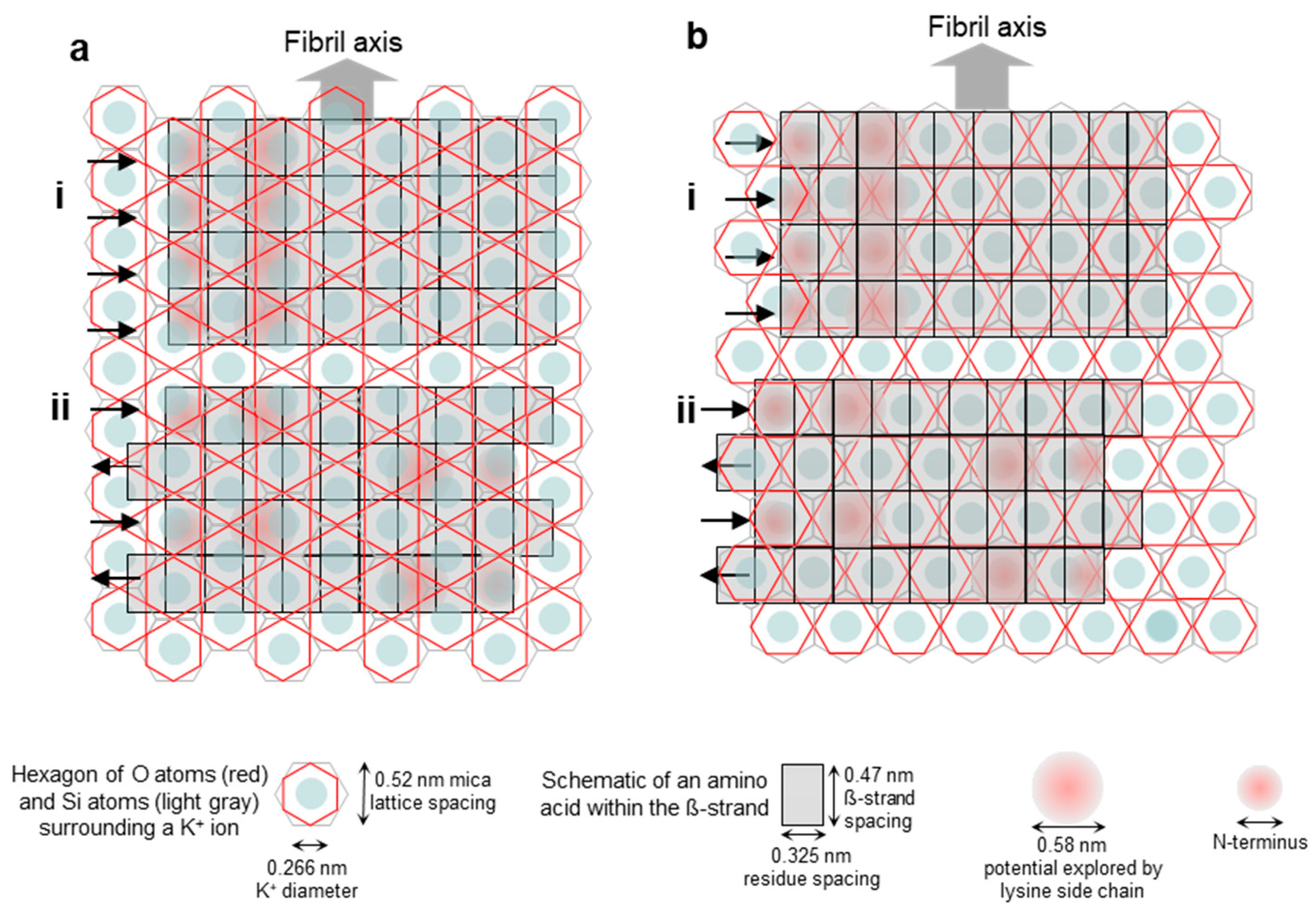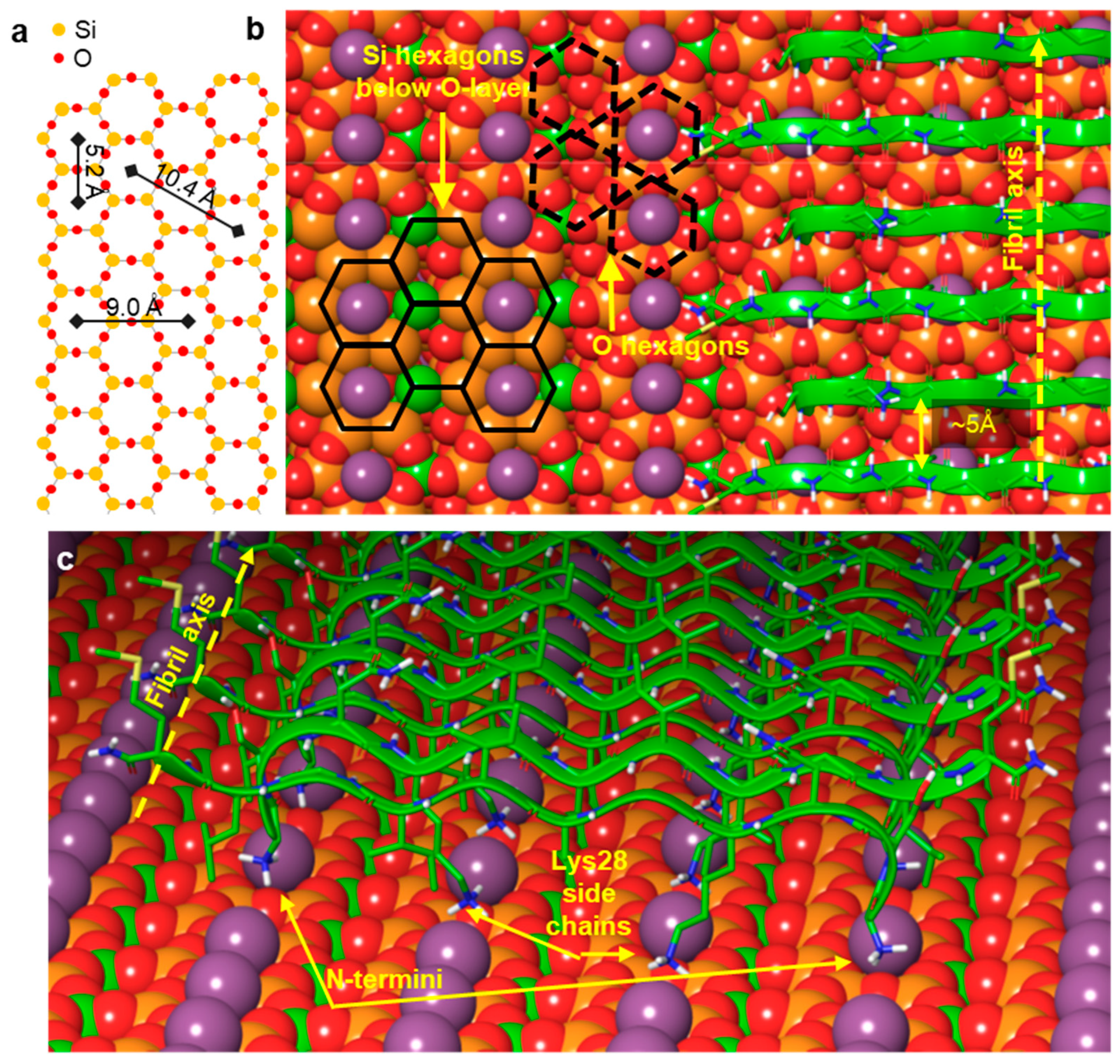Mica Lattice Orientation of Epitaxially Grown Amyloid β25–35 Fibrils
Abstract
:1. Introduction
2. Results and Discussion
3. Materials and Methods
3.1. Sample Preparation
3.2. Atomic Force Microscopy
3.3. Image Processing and Data Analysis
3.4. Molecular Dynamics Simulation
4. Conclusions
Supplementary Materials
Author Contributions
Funding
Institutional Review Board Statement
Informed Consent Statement
Data Availability Statement
Conflicts of Interest
References
- Hardy, J.; Selkoe, D.J. The Amyloid Hypothesis of Alzheimer’s Disease: Progress and Problems on the Road to Therapeutics. Science 2002, 297, 353–3556. [Google Scholar] [CrossRef] [PubMed]
- Selkoe, D.J. Alzheimer’s disease: Genes, proteins and therapy. Physiol. Rev. 2001, 81, 741–766. [Google Scholar] [CrossRef]
- Selkoe, D.J. Folding proteins in fatal ways. Nature 2003, 426, 900–904. [Google Scholar] [CrossRef] [PubMed]
- Serpell, L.C. Alzheimer’s amyloid fibrils: Structure and assembly. Biochim. Biophys. Acta 2000, 1502, 16–30. [Google Scholar] [CrossRef]
- Gazit, E. Use of biomolecular templates for the fabrication of metal nanowires. FEBS J. 2006, 274, 317–322. [Google Scholar] [CrossRef] [PubMed]
- Hamada, D.; Yanagihara, I.; Tsumote, K. Engineering amyloidogenicity towards the development of nanofibrillar materials. Trends Biotechnol. 2004, 22, 93–97. [Google Scholar] [CrossRef] [PubMed]
- Reches, M.; Gazit, E. Casting metal nanowires within discrete self-assembled peptide nanotubes. Science 2003, 300, 625–627. [Google Scholar] [CrossRef]
- Scheibel, T.; Parthasarathy, R.; Sawicki, G.; Lin, X.M.; Jaeger, H.; Lindquist, S.L. Conducting nanowires built by controlled self-assembly of amyloid fibers and selective metal deposition. Proc. Natl. Acad. Sci. USA 2003, 100, 4527–4532. [Google Scholar] [CrossRef]
- Zarándi, M.; Soós, K.; Fülöp, L.; Bozsó, Z.; Datki, Z.; Tóth, G.K.; Penke, B. Synthesis of Aβ[1-42] and its derivatives with improved efficiency. J. Pept. Sci. 2007, 13, 94–99. [Google Scholar] [CrossRef]
- Mattson, M.P. Pathways towards and away from Alzheimer’s disease. Nature 2004, 430, 631–639. [Google Scholar] [CrossRef]
- Selkoe, D.J. Images in neuroscience. Alzheimer’s disease: From genes to pathogenesis. Am. J. Psychiatry 1997, 154, 1198. [Google Scholar] [PubMed]
- Forloni, G.; Chiesa, R.; Smiroldo, S.; Verga, L.; Salmona, M.; Tagliavini, F.; Angeretti, N. Apoptosis mediated neurotoxicity induced by chronic application of beta amyloid fragment 25–35. Neuroreport 1993, 4, 523–526. [Google Scholar] [CrossRef] [PubMed]
- Pike, C.J.; Walencewicz-Wasserman, A.J.; Kosmoski, J.; Cribbs, D.H.; Glabe, C.G.; Cotman, C.W. Structure-activity analyses of beta-amyloid peptides: Contributions of the beta 25–35 region to aggregation and neurotoxicity. J. Neurochem. 1995, 64, 253–265. [Google Scholar] [CrossRef] [PubMed]
- Yang, D.S.; Yip, C.M.; Huang, T.H.; Chakrabartty, A.; Fraser, P.E. Manipulating the amyloid-beta aggregation pathway with chemical chaperones. J. Biol. Chem. 1999, 274, 32970–32974. [Google Scholar] [CrossRef]
- del Mar Martinez-Senac, M.; Villalain, J.; Gómez-Fernández, J.C. Structure of the Alzheimer β-amyloid peptide (25–35) and its interaction with negatively charged phospholipid vesicles. Eur. J. Biochem. 1999, 265, 744–753. [Google Scholar] [CrossRef]
- Terzi, E.; Holzemann, G.; Seelig, J. Alzheimer beta-amyloid peptide 25–35: Electrostatic interactions with phospholipid membranes. Biochemistry 1994, 33, 7434–7441. [Google Scholar] [CrossRef]
- Brigatti, M.F.; Guggenheim, S.; Poppi, M. Crystal chemistry of the 1M mica polytype: The octahedral sheet. Am. Mineral. 2003, 88, 667–675. [Google Scholar] [CrossRef]
- Franzini, M. The A and B mica layers and the crystal structure of sheet silicates. Contr. Mineral. Petrol. 1969, 21, 203–224. [Google Scholar] [CrossRef]
- Giese, R.F.J. Hydroxyl orientations in 2:1 phyllosilicates. Clays Clay Miner. 1979, 27, 213–223. [Google Scholar] [CrossRef]
- Akutagawa, T.; Ohta, T.; Hasegawa, T.; Nakamura, T.; Christensen, C.A.; Becher, J. Formation of oriented molecular nanowires on mica surface. Proc. Natl. Acad. Sci. USA 2002, 99, 5028–5033. [Google Scholar] [CrossRef]
- Li, M.; Wang, A.; Mao, G.; Daehne, L. Surface-directed adsorption in the epitaxy growth of streptocyanine dye crystals. J. Phys. Chem. B 1999, 103, 11161–11168. [Google Scholar] [CrossRef]
- Karsai, Á.; Grama, L.; Murvai, Ü.; Soós, K.; Penke, B.; Kellermayer, M.S.Z. Potassium-dependent oriented growth of amyloid β25–35 fibrils on mica. Nanotechnology 2007, 18, 345102. [Google Scholar] [CrossRef]
- Karsai, A.; Nagy, A.; Kengyel, A.; Martonfalvi, Z.; Grama, L.; Penke, B.; Kellermayer, M.S. Effect of lysine-28 side-chain acetylation on the nanomechanical behavior of alzheimer amyloid β25–35 fibrils. J. Chem. Inf. Model. 2005, 45, 1641–1646. [Google Scholar] [CrossRef] [PubMed]
- Kellermayer, M.S.; Karsai, A.; Benke, M.; Soos, K.; Penke, B. Stepwise dynamics of epitaxially growing single amyloid fibrils. Proc. Natl. Acad. Sci. USA 2008, 105, 141–144. [Google Scholar] [CrossRef] [PubMed]
- Murvai, U.; Somkuti, J.; Smeller, L.; Penke, B.; Kellermayer, M.S. Structural and nanomechanical comparison of epitaxially and solution-grown amyloid β25–35 fibrils. Biochim. Biophys. Acta 2015, 1854, 327–332. [Google Scholar] [CrossRef]
- Kang, S.G.; Li, H.; Huynh, T.; Zhang, F.; Xia, Z.; Zhang, Y.; Zhou, R. Molecular mechanism of surface-assisted epitaxial self-assembly of amyloid-like peptides. ACS Nano 2012, 6, 9276–9282. [Google Scholar] [CrossRef]
- Rothel, C.; Radziown, M.; Resel, R.; Zimmer, A.; Simbrunner, C.; Werzer, O. Complex Behavior of Caffeine Crystallites on Muscovite Mica Surfaces. Cryst. Growth Des. 2015, 15, 4563–4570. [Google Scholar] [CrossRef]
- Xie, M.; Li, H.; Ye, M.; Zhang, Y.; Hu, J. Peptide self-assembly on mica under ethanol-containing atmospheres: Effects of ethanol on epitaxial growth of peptide nanofilaments. J. Phys. Chem. B 2012, 116, 2927–2933. [Google Scholar] [CrossRef]
- Kellermayer, M.S.; Grama, L.; Karsai, A.; Nagy, A.; Kahn, A.; Datki, Z.L.; Penke, B. Reversible mechanical unzipping of amyloid beta-fibrils. J. Biol. Chem. 2005, 280, 8464–8470. [Google Scholar] [CrossRef]
- Martin, J.; Letellier, G.; Marin, A.; Taly, J.F.; de Brevern, A.G.; Gibrat, J.F. Protein secondary structure assignment revisited: A detailed analysis of different assignment methods. BMC Struct. Biol. 2005, 5, 17. [Google Scholar] [CrossRef]
- Karsai, A.; Murvai, U.; Soos, K.; Penke, B.; Kellermayer, M.S. Oriented epitaxial growth of amyloid fibrils of the N27C mutant β25–35 peptide. Eur. Biophys. J. 2008, 37, 1133–1137. [Google Scholar] [CrossRef] [PubMed]
- Kellermayer, M.S.; Murvai, U.; Horvath, A.; Laszloffi, E.; Soos, K.; Penke, B. Epitaxial assembly dynamics of mutant amyloid β25–35_N27C fibrils explored with time-resolved scanning force microscopy. Biophys. Chem. 2013, 184, 54–61. [Google Scholar] [CrossRef]
- Smith, P.K.; Krohn, R.I.; Hermanson, G.T.; Mallia, A.K.; Gartner, F.H.; Provenzano, M.D.; Fujimoto, E.K.; Goeke, N.M.; Olson, B.J.; Klenk, D.C. Measurement of protein using bicinchoninic acid. Anal. Biochem. 1985, 150, 76–85. [Google Scholar] [CrossRef]
- Loewenstein, W. The distribution of aluminum in the tetrahedra of silicates and aluminates. Am. Mineral. 1954, 39, 92–96. [Google Scholar]
- Kuwahara, Y. Muscovite surface structure imaged by fluid contact mode AFM. Phys. Chem. Miner. 1999, 26, 198–205. [Google Scholar] [CrossRef]
- Momma, K.; Izumi, F. VESTA for three-dimensional visualization of crystal, volumetric and morphology data. J. Appl. Crystallogr. 2011, 44, 1272–1276. [Google Scholar] [CrossRef]
- Maestro, Schrödinger LLC. Schrödinger Release 2022-4; Maestro, Schrödinger, LLC: New York, NY, USA, 2022. [Google Scholar]
- Jorgensen, W.L.; Chandrasekhar, J.; Madura, J.D.; Impey, R.W.; Klein, M.L. Comparison of Simple Potential Functions for Simulating Liquid Water. J. Chem. Phys. 1983, 79, 926–935. [Google Scholar] [CrossRef]
- Humphrey, W.; Dalke, A.; Schulten, K. VMD: Visual molecular dynamics. J. Mol. Graph. Model. 1996, 14, 33–38. [Google Scholar] [CrossRef]
- Phillips, J.C.; Braun, R.; Wang, W.; Gumbart, J.; Tajkhorshid, E.; Villa, E.; Chipot, C.; Skeel, R.D.; Kalé, L.; Schulten, K. Scalable molecular dynamics with NAMD. J. Comput. Chem. 2005, 26, 1781–1802. [Google Scholar] [CrossRef]
- MacKerell, A.D.; Bashford, D.; Bellott, M.; Dunbrack, R.L.; Evanseck, J.D.; Field, M.J.; Fischer, S.; Gao, J.; Guo, H.; Ha, S.; et al. All-atom empirical potential for molecular modeling and dynamics studies of proteins. J. Phys. Chem. B 1998, 102, 3586–3616. [Google Scholar] [CrossRef]
- Cygan, R.T.; Liang, J.J.; Kalinichev, A.G. Molecular models of hydroxide, oxyhydroxide, and clay phases and the development of a general force field. J. Phys. Chem. B 2004, 108, 1255–1266. [Google Scholar] [CrossRef]
- Heine, D.R.; Rammohan, A.R.; Balakrishnan, J. Atomistic simulations of the interaction between lipid bilayers and substrates. Mol. Simulat 2007, 33, 391–397. [Google Scholar] [CrossRef]
- Darden, T.; York, D.; Pedersen, L. Particle Mesh Ewald—An N.Log(N) Method for Ewald Sums in Large Systems. J. Chem. Phys. 1993, 98, 10089–10092. [Google Scholar] [CrossRef]





Disclaimer/Publisher’s Note: The statements, opinions and data contained in all publications are solely those of the individual author(s) and contributor(s) and not of MDPI and/or the editor(s). MDPI and/or the editor(s) disclaim responsibility for any injury to people or property resulting from any ideas, methods, instructions or products referred to in the content. |
© 2024 by the authors. Licensee MDPI, Basel, Switzerland. This article is an open access article distributed under the terms and conditions of the Creative Commons Attribution (CC BY) license (https://creativecommons.org/licenses/by/4.0/).
Share and Cite
Ferenczy, G.G.; Murvai, Ü.; Fülöp, L.; Kellermayer, M. Mica Lattice Orientation of Epitaxially Grown Amyloid β25–35 Fibrils. Int. J. Mol. Sci. 2024, 25, 10460. https://doi.org/10.3390/ijms251910460
Ferenczy GG, Murvai Ü, Fülöp L, Kellermayer M. Mica Lattice Orientation of Epitaxially Grown Amyloid β25–35 Fibrils. International Journal of Molecular Sciences. 2024; 25(19):10460. https://doi.org/10.3390/ijms251910460
Chicago/Turabian StyleFerenczy, György G., Ünige Murvai, Lívia Fülöp, and Miklós Kellermayer. 2024. "Mica Lattice Orientation of Epitaxially Grown Amyloid β25–35 Fibrils" International Journal of Molecular Sciences 25, no. 19: 10460. https://doi.org/10.3390/ijms251910460





